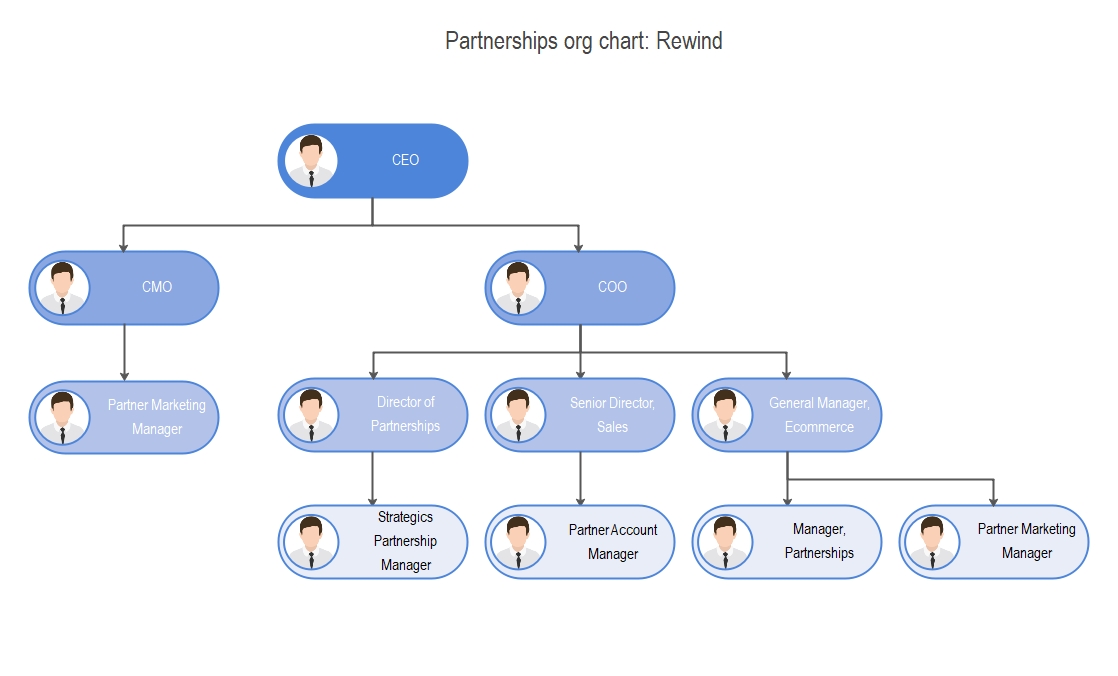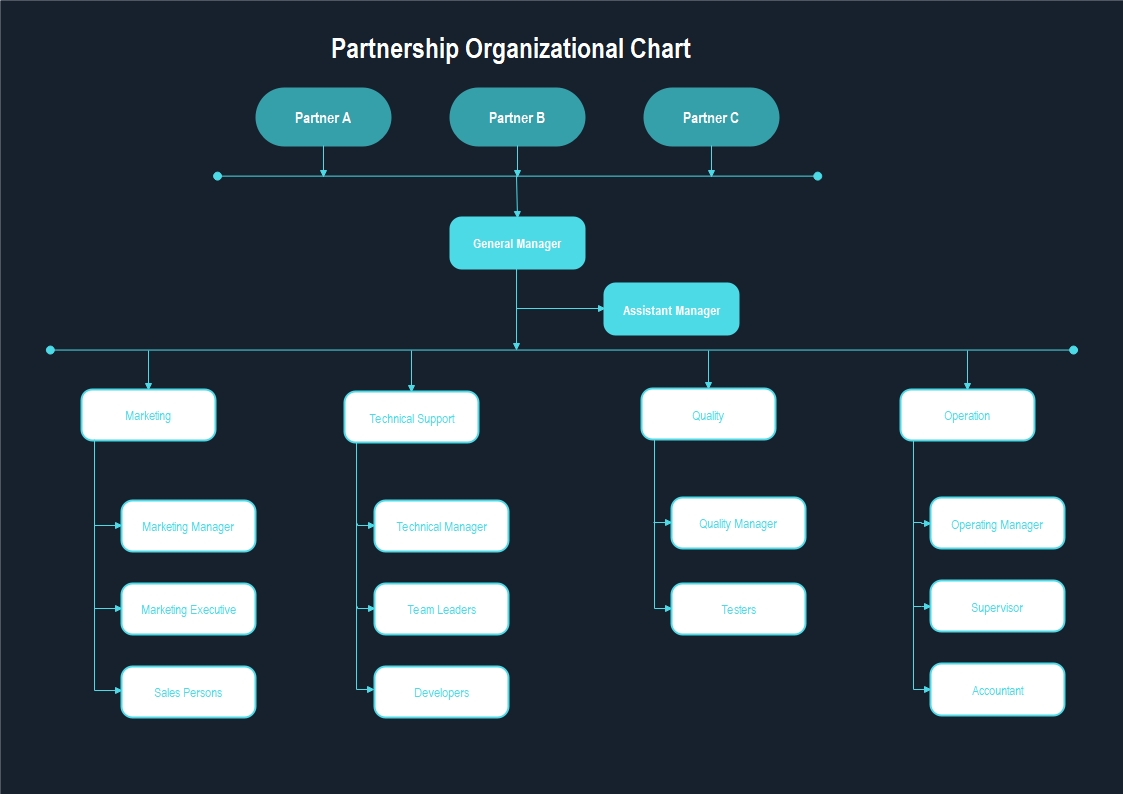Basics of Partnership Organizational Chart
We have profoundly described the partnership organizational chart, its examples, benefits, drawbacks, and tips for its rightful implementation to elevate your partnership business.
1. Introduction

Businesses on all scales consistently reshape lives by integrating new trends. Whatever the business you run, you work on particular products or services, so being an entrepreneur, you must be fully familiar with the company's objectives and product management org structure so that smoothly performed routine operations can be ensured.
Given this requisite, a visual organizational chart is an excellent way to let the stakeholders perceive their roles, responsibilities, and business operation precisely & conveniently. You can implement a custom partnership organizational chart, even in partnership-based businesses, to detail different roles, functions, and relationships among business personnel.
2. Insights into the Partnership Business
Before moving to the core subject, having insights into the Partnership businesses is important. When two or more parties endorse a formal settlement to operate a firm or company conjointly and split the profits, such a business is referred to as a Partnership business.
To build a sound Partnership, all associated parties get designated with certain roles & responsibilities to carry on the business plan. Partnership-based businesses are often considered crucial for corporate growth; holding potential partners in a business is an excellent means to aggrandize your business leading to the ultimate success.
3. Overview of Partnership Organizational Chart
A partnership-based enterprise can plunge into versatile confusion because of the divided roles between two variant parties. To clarify that confusion, it is essential to develop a functional roadmap, unambiguously describing the role of each side. Additionally, partnership businesses are structured differently because each business holds different types of needs, objectives, functioning patterns, and future ambitions. It is where the role of a well-developed partnership organizational chart comes in.
A partnership organizational chart is a visualized framework, spotlighting the responsibilities of both sides for a smooth operational workflow and balanced division of labor. The presence of an efficiently-formed partnership organizational chart hugely impacts the business performance output. Providing a direction to partnership enterprises, partnership org charts expedite the business yields since the chain of command is straightforward and seamless.
Additionally, the organizational chart for partnership businesses allows external stakeholders to understand who is steering the ship, assisting companies in gaining new projects.
4. Understanding the Organizational Structure of Partnership Business
The organizational structure of a partnership business depends on the type of partnership one holds in his entrepreneurship. There are three most common types of partnerships in a business: general, limited, and limited liability partnership.
General Partnership Organizational Structure
In the general partnership type, all the shareholders have financial and legal liability equally, without giving priority to any specific partner. The profits and losses are also equally shared by each party.
The organizational structure of a general partnership organization comprises two or more peer-level partners, having hierarchical staff working under them.
Limited Liability Partnership Organizational Structure
The limited liability partnership restricts the partner's personal liability, so if one partner is involved in the illegal practice, the monetary assets of the other partner would not be at risk.
Such a type of partnership has a discrepant organizational structure, in which one partner has limited access to authority while the other partner enjoys more privileges regarding management.
Limited Partnership Organizational Structure
The limited partnership is an amalgam of both general and limited liability partnership, in which one partner is a general member acquiring all rights about management, whereas the other is a silent partner and does not participate in day-to-day operational or management-related activities.
The organizational structure of such partnership organizations solely contains the authority of the general partner, having all privileges of maintaining, managing, and updating the business.
5. Examples of Organizational Charts for Partnership Business
The visual examples profoundly illustrate the management mechanism within a partnership-based business organizational chart. We have described some genuine examples of partnership-based business org charts from variant sources for your insight:
The type of partnership org chart illustrated above is the public-private partnership, in which one partner is responsible for managing private affairs while the other controls public affairs. The private partner manages the company's internal operations, maintenance, investment, and other tasks. On the other hand, the public partner controls the legal affairs, accounting, sales, and other supplementary tasks.
The COO is responsible for managing the coordination of all activities between partnerships and within the rest of the organization because of having access and insight into other executive initiatives. The responsibility of the CMO manager is only to manage the marketing, encouraging the audience to acquire their product. Overall, the COO is the overall manager of the company's operational responsibilities, controlling finance, sales, accounting, and other managerial tasks.
This partnership organizational chart is a visual representation of the structure of a company that is owned and operated by a group of partners. The partners are at the top of the chart, and they are responsible for making strategic decisions and setting the overall direction of the company.
Underneath them, the General Manager is responsible for managing the day-to-day activities and business operations of the company. The General Manager reports directly to the partners and is accountable for ensuring that the company is meeting its objectives and goals.
6. How to Create a Partnership Organizational Chart?
Since partnership-based organizations contain a considerably complicated and well-knit structure, remembering all the complex designations set in your organization or enterprise may prove genuinely a tedious task. In such a situation, devising a visually appealing partnership organizational chart will enable you to effortlessly remember the hierarchical entities within your organization because of its clarity and vibrancy.
The market is flooded with several diagramming tools, but only the rare are those tools that befit every type of user, price range, features line, and design requirements, such as EdrawMax. Whether it's an org chart, concept map, roadmap, flowchart, or other business diagrams, EdrawMax inspires innovation into your diagramming experience to exude your creativity onto the canvas.
Creating A Partnership Organizational Chart Using Edrawmax:
With its intuitive interface, you can set your imagination free to contriving an impeccable masterpiece. Here is the in-depth procedure for creating your ideal organizational chart for a partnership business:
Step 1: Download the "EdrawMax" application to utilize it for partnership organizational chart creation.
Step 2: To initiate your diagramming from scratch, click the "New" option from the left panel and choose the "Org Chart" option from the main interface. If you want to edit a premade template, click the "Templates" option.
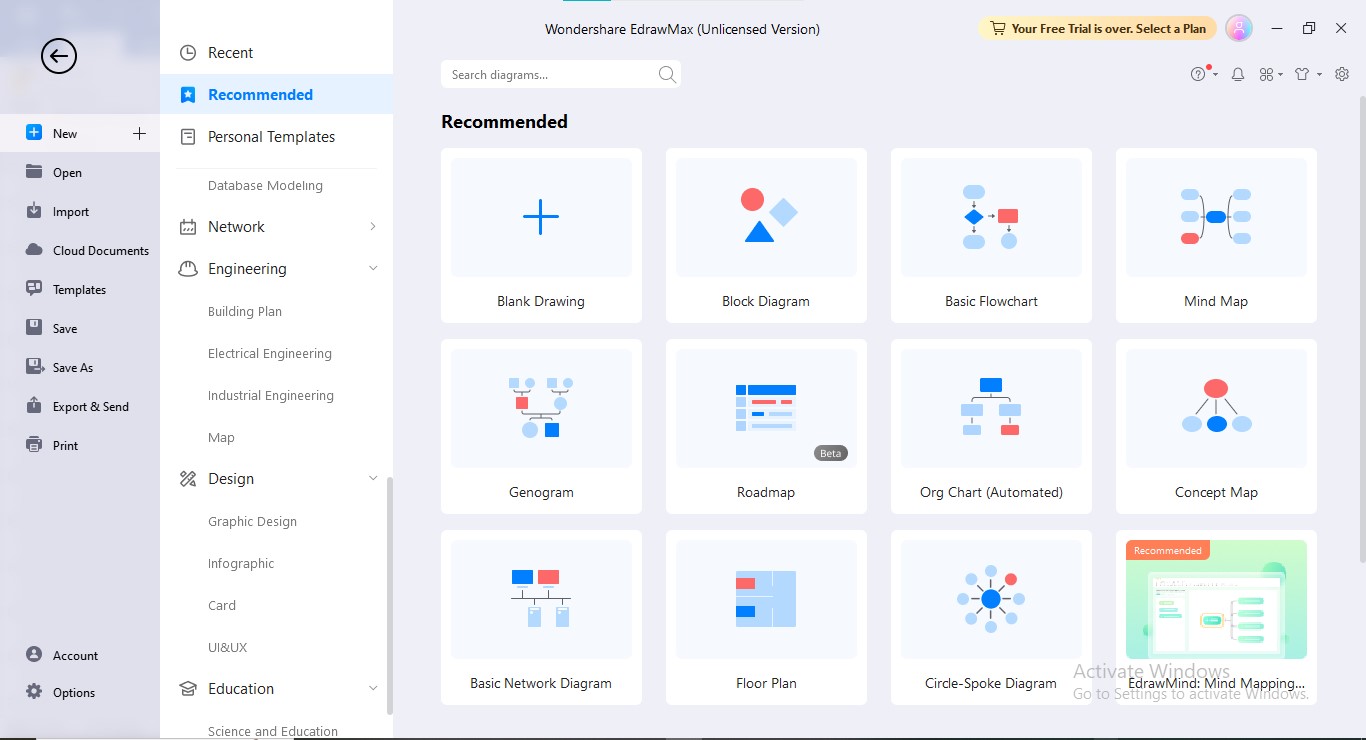
Step 3: Enter the required information into your partnership organizational chart to complete it.
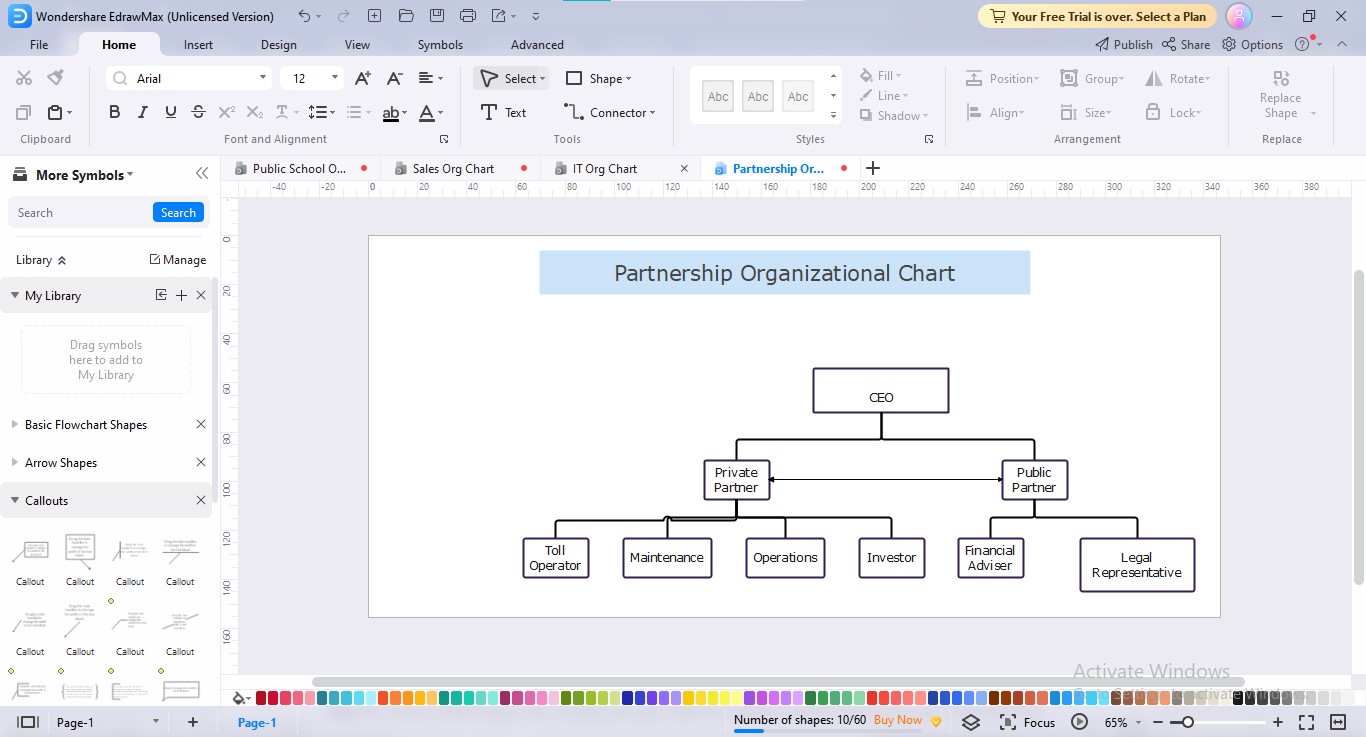
Step 4: After establishing the organizational chart by adding shapes and necessary information, customize it using your favorite color scheme, theme, diagram layout, and background color.

Step 5: Click the "Export" button at the top bar to save the file in your desired format.
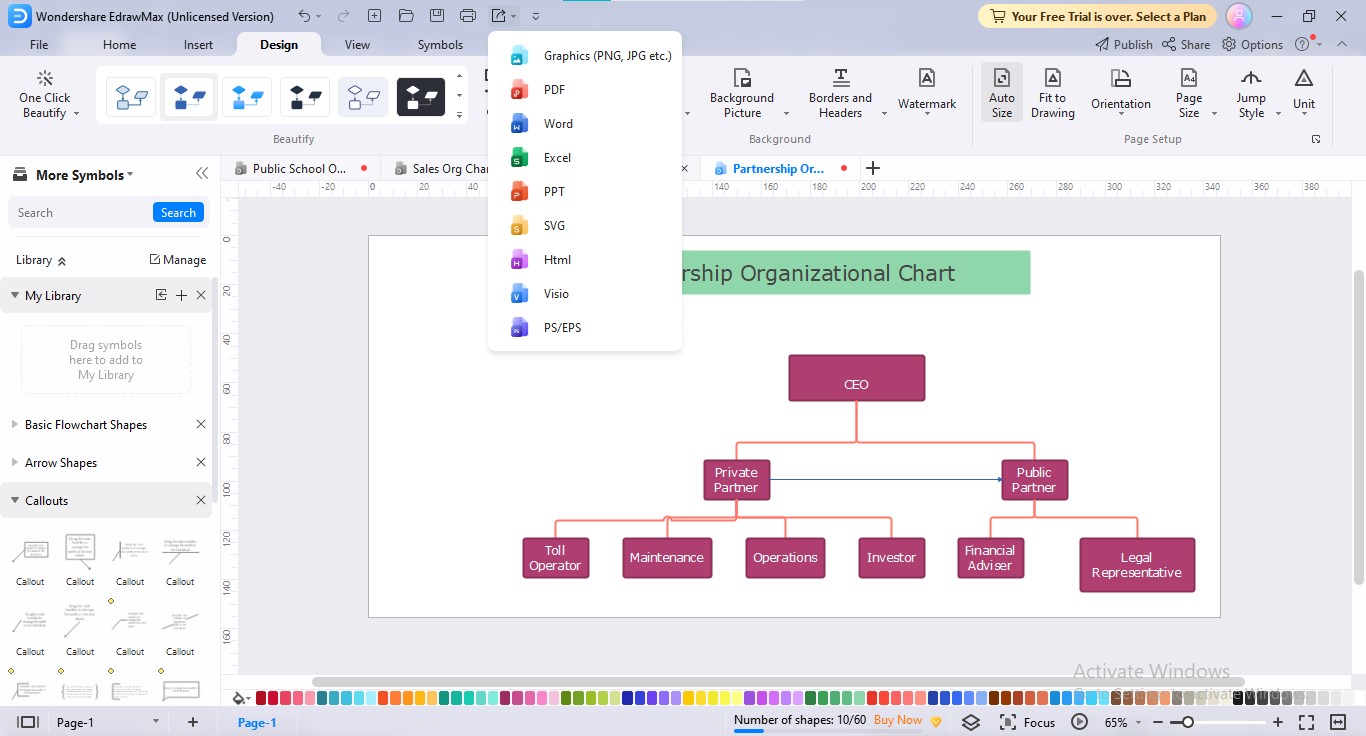
7. How to Use an Organizational Chart in a Partnership Business? Four Useful Tips
The implementation of your organizational chart within your business circle is as essential as its creation, requiring you to establish certain policies to monitor its rightful implementation, maintenance, and updation. Given this need, we have curated a few helpful tips that will assist you in analyzing whether your newly created partnership org chart is accurately incorporated into your organization:
- It has always been a good idea to disseminate the overall organizational structure chart to all the personnel so that they absolutely know both their and others' responsibilities.
- Develop an action plan to monitor whether the company's day-to-day operational activities are being performed according to the organizational chart instructions. You can also allocate a person to manage the supervision task.
- Evaluate your employees through various assessment techniques, including questionnaires, feedback, surveys, and superior-subordinate meetings to analyze the degree of their comprehension & interest towards your organizational chart policies.
- Make strict policies to prevent bureaucracy within the two halves of the partnership organizational vista. One partnership community must not interrupt or intercept the other one's operations.
8. Advantages & Limitations of Using Org Chart in Partnership Businesses
Every business approach carries both good and bad sides. It is because a particular business strategy or approach may be suitable for one business situation but unsuitable for the other since every business has a different nature, needs, resources, employees, work environment, geographic location, and product range. Thus, having an organizational chart within the system can impact the partnership organization in both good and bad ways.
Advantages of Using Org Chart in Partnership Businesses:
- The hierarchical categorization of designations allows workers to know their day-to-day responsibilities, ensuring they are completing their tasks with full stamina.
- A properly-built organizational structure in a partnership business enables efficient workload management, especially if the number of employees is less, as in the case of a startup company.
- An organizational structure in a partnership enterprise establishes an unbroken chain of command, allowing employees to receive an accurate set of instructions from their superiors.
- If your partnership organization is pretty large with a massive number of workers, the management of employees would be effortless and checkable using a partnership organizational chart.
- When the organizational chart is implemented properly in the partnership business, it will lead to improved performance and augmented revenues since each worker is performing their duties aptly.
- Implementing a well-coordinated organizational structure in your partnership business facilitates efficient crisis management, especially in case of a bottleneck; the clear reporting structure allows swift problem-solving.
- The partnership organizational chart promotes prompt communication at all levels, allowing the management and worker tiers to discuss their day-to-day needs and encountered hindrances without hassle.
Disadvantages of Using Org Chart in Partnership Businesses:
- Due to the hierarchical division of labor, some superiors may develop a monopoly over their subordinates, suppressing them from their own whims rather than focusing on the company's pivotal objectives. Additionally, one partnership management tier can dominate the other ones, compelling them to act according to their strategies.
- If the organizational structure in a partnership business is implemented wrongly or doesn't exhibit the expected outcomes, the other partner would also be affected. For example, if a partner managing marketing & sales does not comply with the company's policies, the other partner would also face a loss in the form of lowered revenues.
- Building an action plan or proper checks and balances for monitoring structural implementations may consume considerable time and resources, usually necessitating hiring a separate employee.
- The precious time required for necessary business tasks may be consumed on managing the proper organizational structure of the company.
9. Conclusion
A partnership business, usually preferred by startup enterprises, amateur businessmen, and novice companies, involves two or more partners who invest equal resources to develop a joint business. Developing an organizational chart for a partnership business is inevitable because it allows both sides to focus on their objectives, keeping them on track.
Implementing the organizational chart within a partnership enterprise carries both advantages and disadvantages. The advantages include efficient business management, seamless reporting structure, enhanced communication among workers, and elevated performance.
On the other hand, the disadvantages encompass unnecessary bureaucracy, lack of understanding about the business nature, implementation failure, and redundant time & resource consumption. However, these drawbacks can be prevented with proper strategizing, such as unbiased evaluation and monitoring.

 below.
below. 